Introduction to Metallographic for Powder Metallurgy 粉制金金相技術 (二)
接續三月刊
1.2Sectioning切片
Samples selected for metallographic examination in the as-received state are rarely in the condition to be prepared for metallographic examination. Almost all must be reduced in size or have a specific section removed prior to preparation. 在所接收的需要檢驗的金相檢驗樣品,很少可以直接進 行觀察的,幾乎所有的樣品必須在觀察前在尺寸上或有 一個特定的部分進行材料移除,才能夠被進行觀察。
1.2.1 Pre-sectioning預切片
In some cases, the parts are too large for the available metallographic sectioning equipment and presectioning is required. This is normally accomplished with a non-precision device such as a hacksaw, band saw, or abrasive cutter. It is vitally important that the preliminary reduction in sample size be performed in an area a significant distance from the regions intended for analysis. Usually, the blade or sample feed, blade pressure on the sample, and/or coolant flow is not sufficient to protect the sample from substantial damage.
This may render the sample unusable or require an exaggerated amount of grinding to eliminate the thick layer of surface damage. 在某些情況下,零件太大時可用金相切片設備,預切 是被要求進行的步驟。這通常是一個非精密設備如手 工鋸、機械鋸床或砂輪切割機完成。這是非常重要, 這些不要的區域離被觀察區域有顯著的距離,藉以使 樣品大小進行初步的減少。要注意到選擇正確的設備 切刀片或樣品的進給速度、切刀片壓力或冷卻液流量 以保護樣品觀察區,避免發生實質性損害。如不注意, 可能使樣品不可使用或需要一個更誇張的磨削量以消 除較厚的表面損傷層。
P1-Fig.5 (a and b) shows an extreme example of the depth and extent of surface damage from presectioning. The prepared surface shown in these images was sectioned perpendicular to the presectioned cut, where the upper side of the crosssection is the location of the pre-section cut. The force of the blade cutting into the sample was sufficient to create an artificial increase in density along this surface (P1-Fig.5a) in addition to the material flow seen in P1-Fig.5b. The combination of transformation products has also been altered due to overheating, where the coolant flow and cooling capacity was not capable of preventing considerable microstructural damage. P1-圖.5(a及b) 顯示從預切片的手法,造成樣品在深 度和表面損傷程度的極端例子。製備樣品的表面顯示 著,當切片垂直於預分段切割,在橫截面上的預剖切 位置,刀片的切割樣品的力量足以創造沿著切割面密 度受到人為的增加(P1-圖.5A) ,並且在P1-圖.5b看 到物質流動的痕跡。產品受到不恰當的應力使表面組 織被改變,由於過熱、冷卻液流量和冷卻能力不夠, 無法防止微結構受到損傷。
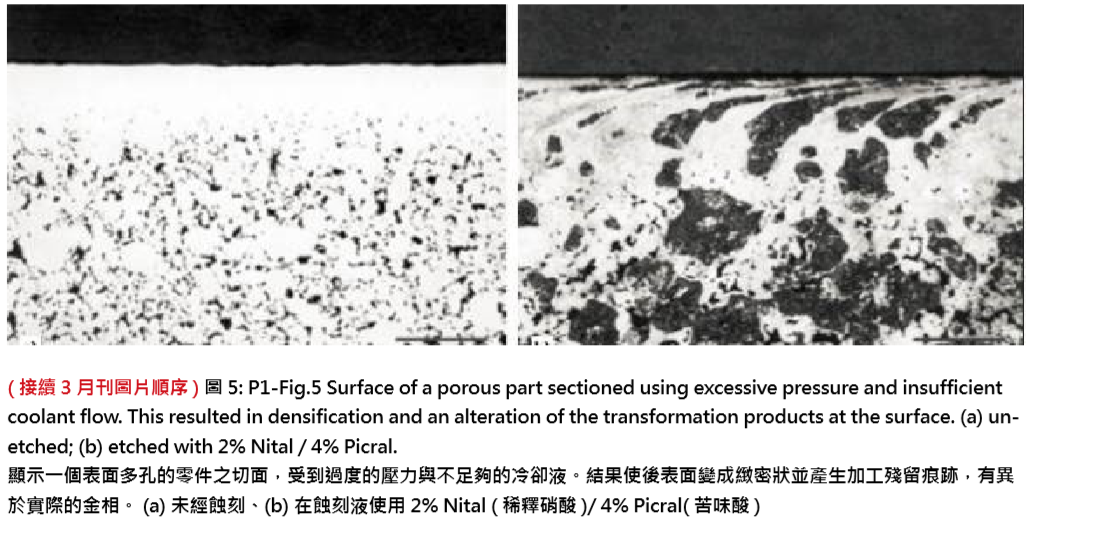
Another example of improper abrasive sectioning can be seen in P1-Fig.6. The dangers of insufficient cooling when using an abrasive saw are seen as a change in the transformation products. In the lower magnification example, P1-Fig.6a, three distinct colors can be seen in the cross-section; light tan on the outside (left side), dark blue to dark grey in the middle, and an orange/brown layer on the inside (right side) of the sample section.
另一個例子,不當研磨切片如P1-圖.6中可以看出。 當使用研磨劑時,冷卻不足的危險被視為轉變產品 金相的一種原因。在低倍率的例子可以看到如P1圖.6a,可以從橫截面上看到三種不同的顏色;在最 外面(左側)是光亮的,在中間的是深藍色到深灰色, 並在最裡面看到橙色/棕色層(右側)的部分。
Each color represents a different combination of transformation products with only the inside layer toward the right side being correct. The first two layers are seen at a higher magnification in P1-Fig.6b as Martensite and retained Austenite along the outside edge and a Bainitic layer as the intermediate transformation product.
每一種顏色都代表一種不同樣品的金相組合,只有內 部層是正確的。第一層(光亮層)在更高的放大如P1圖.6b為馬氏體和殘餘奧氏體,然後發藍的變韌體作 為中間轉換的微結構。
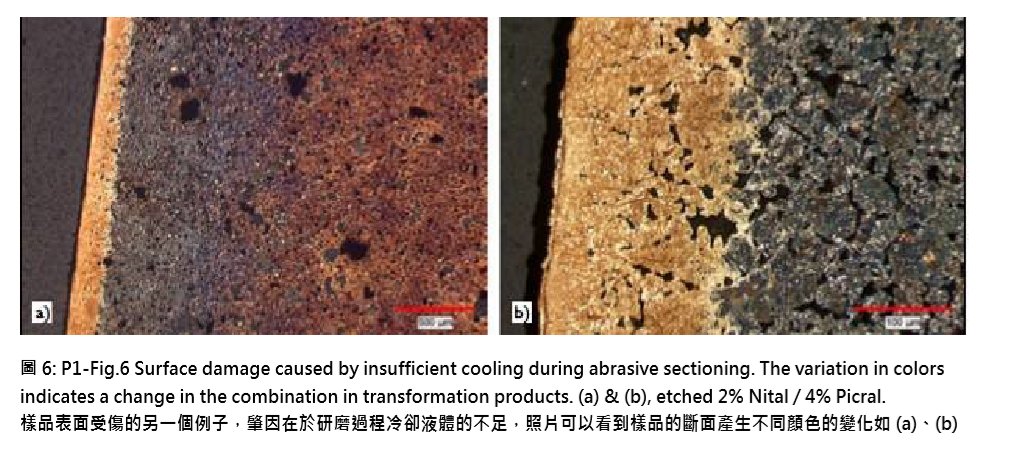
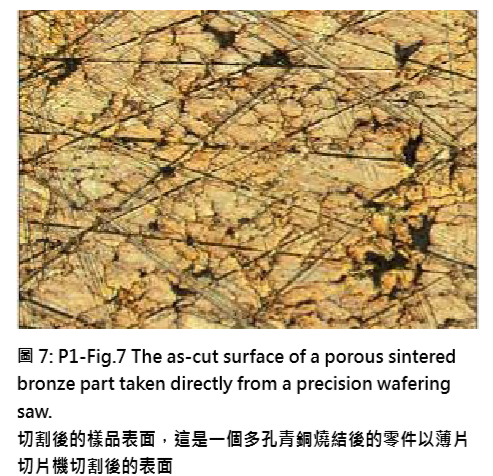
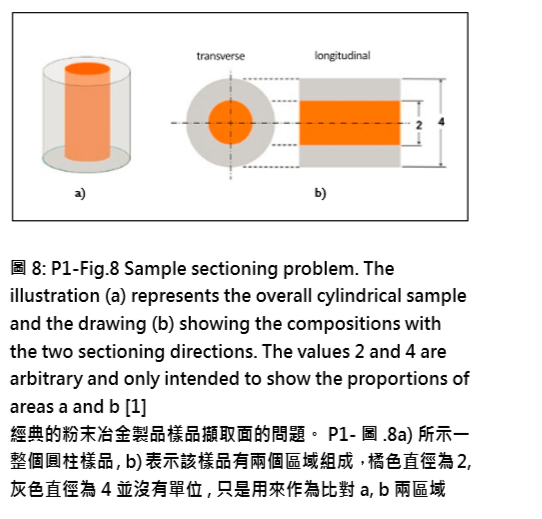
1.2.2 Precise sectioning精密切片
A wafering saw can be used as an alternative sectioning method if precise section location or sample protection is required. This device uses a blade that is substantially thinner than what is used in a typical metallographic cut-off abrasive saw. The blades are composed of SiC, Al2O3, or other abrasive materials. In addition, metallic substrate blades with a diamond impregnated rim are sometimes used. Location of the blade on the sample is often made using a micrometer.
如果要進行精確的切面或樣品需要保護,那使用薄片 切片機可以用來作為一種替代的砂輪切片的方法。基 本上,典型的金相切割是採用傳統砂輪切片,該裝置 使用的是一個薄片砂輪,是由碳化矽、氧化鋁、或其 他磨料所構成。但薄片式的則是以金屬基板的作為刀 片,在其表面外圈鑲有鑽石的薄片,在刀片的位置往 往僅佔有一個微米的厚度。
Consequently, the position of the cut surface is more accurate compared with the other sectioning methods and relatively thin sections can be produced if desired. The amount of surface damage is also substantially less than what would be generated using the other sectioning techniques due to the small amount of material being removed and the light loads on the sample. P1-Fig.7 shows an as-cut surface from a porous PM sintered bronze part. The scratch pattern from the abrasive contact is apparent, as would be expected, but several of the pores are already visible and have not been filled with the cut metal, even though bronze is relatively soft. This sectioning process has several drawbacks. It is much slower, possibly requiring several minutes to remove a small section, only relatively small samples can be sectioned and the thin blades are easily damaged.
因為較薄的切片與其他方法相比,切片可以產生所需 的樣品並使加工表面的位置更準確;同時,表面的損 傷量也大幅低於傳統使用的砂輪切片技術,這是由於材料去除量小且有較輕量的切割載荷。 P1-圖.7顯示 了一個從多孔粉末燒結青銅零件的切割後表面,明顯的可看到預期的磨料接觸的划痕,正如預期的那樣, 即使青銅相對來說是很柔軟但幾個小孔已經可看到, 並沒有被填充切割後的金屬屑。
這個薄片切片的過程中還是有幾個缺點,這是非常慢 的,可能需要幾分鐘來刪除的一小部分,只能切割相 對較小的樣品,以及薄片刀片易損壞。
1.2.3 Choosing the cross section選擇橫 切面
In addition to ensuring the cutting conditions in the abrasive saw are correct to protect the sample from damage, another important consideration is determining where the cross-section should be taken. In many situations, the microstructural features contained in the cross-section must be representative of the microstructure in the material volume. Not all planar sections removed from a sintered part satisfy this condition. The following example illustrates this problem with simple sample geometry.
此外,為了保護樣品不受損害,要確認切割用的砂輪 片或薄片的形狀是否良好,並需考慮到另一個重要的 因素是確定的所要切割的橫截面。在許多情況下,此橫截面中所包含的微結構特徵,必須是代表的整個材 料的整體性。並不是整個的燒結件都滿足這種條件, 下面的例子說明了這個問題,一個簡單的樣本幾何。
The decision to be made is where to remove a section from the cylindrical specimen and have this one section represent the entire microstructure of the part volume. The structure of the cylinder is composed of two distinct compositions, one cylindrical in shape located in the centre, extending from top to bottom, and the other surrounding the first, also extending from top to bottom. The diameter of the inner cylinder is half the diameter of the overall cylinder. This is shown in P1-Fig.8 with the orange region, A, and the grey region, B, representing the two microstructures. The question is; in which direction should the single section be removed to represent the overall microstructure in the cylinder?
決定取橫截面樣品是從圓柱樣品的某一節位置,此一 部分必須能代表整個樣品的微觀結構。樣品的結構由 2個不同的圓柱筒狀組成,一個位於中心的圓柱形, 從上到下;另一個圓柱筒則是包覆在第一個圓柱的周 圍,也從上到下延伸。內圓柱的直徑是外圓柱的一半 的直徑。如P1-圖.8中顯示的橙色區域為第一個圓柱, 和灰色區域代表第二個圓柱,代表有2種不同的微觀 結構。問題是,在哪個方向上不會造成某一個部分被 刪除,才能代表整體的微觀結構?
Fig. 8b represents the two sampling directions that were considered. The transverse section is removed across the cylinder circumference and the longitudinal section is taken at the diameter of the circle, from top to bottom. With the diameter of the a composition half the overall diameter, the area occupied by a is remarkably different in the two sections. In the transverse section, a occupies 25% of the overall, a + b area. In comparison, a represents 50% of the a + b area in the longitudinal section. In looking at the individual contributions of a and b to the a + b volume, the transverse section gives the correct proportion of the compositions, 25% a and 75% b. The longitudinal cross-section overestimates the a contribution to the cylinder volume by a factor of 2.
P1-圖.8b代表,採樣須從兩個方面來考慮,一個是 包含直徑的橫截面,另一個是從頂部到下的縱截面。 在包含樣品直徑的橫截面A圖面,在這有兩個部分其所佔的面積是顯著的不同,從橫截面看去a(橘紅色) 僅佔有25%的a+a區域(橘紅色+白色)。比較起來, 在縱截面看a卻佔有50%的面積(a:b=1:1面積比), 如果以不同方是取樣,在a和b對比於a + b的貢獻, 橫截面部可以正確的顯示樣品的芯部比例為25%,但 縱截面75%芯部比例將高估橘紅色體積到達2倍。
It is clear that analyzing an unrepresentative crosssection will result in incorrect observations if the overall microstructure is of interest.
很顯然,分析代表性斷面如果不正確將導致整體組織 分析的失誤。
1.2.4 Removal of liquids 移除液體
Another factor to be considered in the premounting of samples is the entrapment of liquids in the pore structure. Oil, rust inhibitor, or other fluids contained in the pore network can result in analysis problems with PM materials. This not only affects metallographic testing, but chemical analysis results may also be affected if the fluids are not removed prior to testing. Chemical extraction of the liquids can be accomplished using a Soxhlet extractor, as pictured in P1-Fig.9. The apparatus is a condensing unit where a solvent is boiled in the bulb located at the bottom (a), the vapours travel up through the assembly to the condensing area at the top (c), and drip down onto the part located in the centre section (b). The condensed liquid fills the centre section until the syphon tube (d) on the side fills and the collected solvent drains. This process continues for a predetermined time, dissolving the oils in the part. It is crucial that the solvent is capable of dissolving the fluid trapped within the pore network.
在預鑲埋樣品時要考慮的另一個因素是在粉末冶金樣品 孔隙結構中的液體造成包封,可能包住油、防銹劑,或 孔隙中所包含的其他流體,這些因素都可能會導致粉末 材料的分析問題,不僅會影響金相測試,如果這些流體 在測試之前沒有被去除,化學分析的結果也可能會受到 影響。
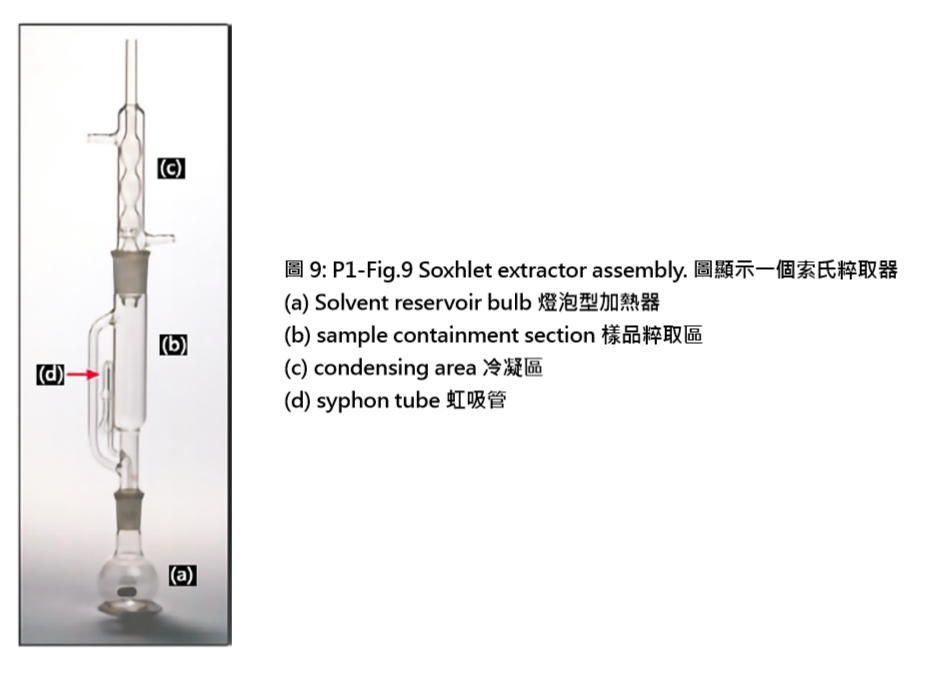
液體的化學萃取可以用索氏粹取器完成,如P1-圖.9。 該裝置是一種以冷凝器組裝在底部是一個燈泡型溶劑煮 沸器,如圖中之(a);蒸汽流經到管路到(c)頂部冷凝區 (必須通水冷卻),樣品則放在(b)中心區接受溶劑的的 滴洗,冷凝的液體填充到中心區直到超過虹吸管(d)邊 上,反复填充和收集的溶劑則漸漸消耗。這個過程持續 了一個預定的時間後,便可溶解零件中的油。至關重要的是,該溶劑能夠溶解被困在孔隙內的不明流體。 (索 氏粹取器基本上就是一個小型的溶劑脫脂爐)
Another method of removing the unwanted liquids is to heat the part under vacuum. The oil, etc. will be forced to the surface of the part and/or outgas under vacuum. The heating temperature should be carefully determined to not alter the microstructure in any way. 除去不需要的液體也可採用另一種方 法,是在真空下加 熱零件,油和流體等將被迫在真空下的分解或是汽化。 但應仔細確定加熱的溫度,以避免任何方式改變了要觀 察的微觀結構。■
